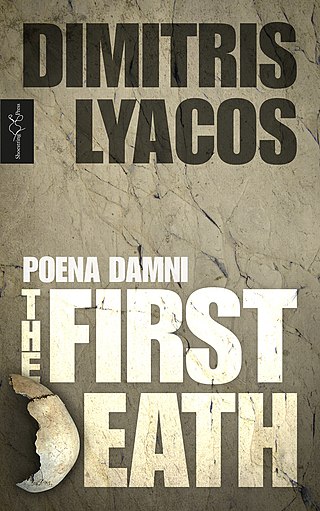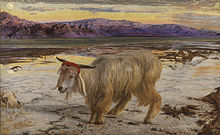The Book ofLeviticus is the third book of the Torah and of the Old Testament, also known as the Third Book of Moses. Many hypotheses presented by scholars as to its origins agree that it developed over a long period of time, reaching its present form during the Persian Period, from 538 to 332 BC, although this is disputed.
A sin offering is a sacrificial offering described and commanded in the Torah ; it could be fine flour or a proper animal. A sin offering also occurs in 2 Chronicles 29:21 where seven bulls, seven rams, seven lambs and seven he-goats were sacrificed on the command of King Hezekiah for the kingdom, for the sanctuary, and for Judah. Like all types of sacrifices offered on the altar, the flour had to be unscented and the animal had to be completely unblemished. This offered sacrifice accompanied the important required core means of atonement for the committing of an unintentional transgression of a prohibition, that either has brought guilt upon the 'community of Israel' or the individual. This offering is brought during or after atonement for those transgressions that had been committed inadvertently, or in ignorance: intentional transgressions could only be absolved by other forms of atonement, or in severe cases kareth. It was distinct from the biblical guilt offering.

According to the Hebrew Bible, the tabernacle, also known as the Tent of the Congregation, was the portable earthly dwelling used by the Israelites from the Exodus until the conquest of Canaan. Moses was instructed at Mount Sinai to construct and transport the tabernacle with the Israelites on their journey through the wilderness and their subsequent conquest of the Promised Land. After 440 years, Solomon's Temple in Jerusalem superseded it as the dwelling-place of God.

In the Hebrew Bible, the name Azazel represents a desolate place where a scapegoat bearing the sins of the Jews was sent during Yom Kippur. During the late Second Temple period, Azazel came to be viewed as a fallen angel responsible for introducing humans to forbidden knowledge, as described in the Book of Enoch. His role as a fallen angel partly remains in Christian and Islamic traditions.

Scapegoating is the practice of singling out a person or group for unmerited blame and consequent negative treatment. Scapegoating may be conducted by individuals against individuals, individuals against groups, groups against individuals, and groups against groups.
Cleromancy is a form of sortition in which an outcome is determined by means that normally would be considered random, such as the rolling of dice (astragalomancy), but that are sometimes believed to reveal the will of a deity.
In Judaism, the korban, also spelled qorban or corban, is any of a variety of sacrificial offerings described and commanded in the Torah. The plural form is korbanot, korbanoth, or korbanos.

In Judaism, ritual washing, or ablution, takes two main forms. Tevilah (טְבִילָה) is a full body immersion in a mikveh, and netilat yadayim is the washing of the hands with a cup.
A pharmakós in Ancient Greek religion was the ritualistic sacrifice or exile of a human scapegoat or victim.

Dimitris Lyacos is a contemporary Greek writer. He is the author of the Poena Damni trilogy. Lyacos's work is characterised by its genre-defying form and the avant-garde combination of themes from literary tradition with elements from ritual, religion, philosophy and anthropology.

Tzav, Tsav, Zav, Sav, or Ṣaw is the 25th weekly Torah portion in the annual Jewish cycle of Torah reading and the second in the Book of Leviticus. The parashah teaches how the priests performed the sacrifices and describes the ordination of Aaron and his sons. The parashah constitutes Leviticus 6:1–8:36. The parashah is made up of 5,096 Hebrew letters, 1,353 Hebrew words, 97 verses, and 170 lines in a Torah scroll. Jews read it the 24th or 25th Sabbath after Simchat Torah, generally in the second half of March or the first half of April.

Tazria, Thazria, Thazri'a, Sazria, or Ki Tazria' is the 27th weekly Torah portion in the annual Jewish cycle of Torah reading and the fourth in the Book of Leviticus. The parashah deals with ritual impurity. It constitutes Leviticus 12:1–13:59. The parashah is made up of 3,667 Hebrew letters, 1,010 Hebrew words, 67 verses, and 128 lines in a Torah Scroll.

Acharei Mot is the 29th weekly Torah portion in the annual Jewish cycle of Torah reading. It is the sixth weekly portion in the Book of Leviticus, containing Leviticus 16:1–18:30. It is named after the fifth and sixth Hebrew words of the parashah, its first distinctive words.

A burnt offering in Judaism is a form of sacrifice first described in the Hebrew Bible. As a tribute to God, a burnt offering was entirely burnt on the altar. This is in contrast to other forms of sacrifice, which was partly burnt and most of it eaten in communion at a sacrificial meal.

The First Death is a book by Dimitris Lyacos. It is part of the Poena Damni trilogy. The book tells the story of a marooned man on a desert island in a sequence of fourteen poem sections, recounting his relentless struggle for survival as well as his physical and mental disintegration. The work alludes simultaneously to a modern Philoctetes, an inverted version of Crusoe as well as the myth of the dismemberment of Dionysus. The dense and nightmarish imagery of the poem, replete with sensations of hallucination, delirium, synesthesia, and putrefaction has drawn comparisons to Lautreamont, Trakl and Beckett. Despite being first in the publication history of the Poena Damni trilogy, The First Death is chronologically last in the narrative sequence.

Z213: Exit is a 2009-2018 novel by Greek author Dimitris Lyacos. It is the first installment of the Poena Damni trilogy. Despite being the first of the trilogy in narrative order, the book was the third to be published in the series. The work develops as a sequence of fragmented diary entries recording the solitary experiences of an unnamed, Ulysses-like persona in the course of a train voyage gradually transformed into an inner exploration of the boundaries between self and reality. The voyage is also akin to the experience of a religious quest with a variety of biblical references, mostly from the Old Testament, being embedded into the text which is often fractured and foregoing punctuation. Most critics place Z213: Exit in a postmodern context exploring correlations with such writers as Samuel Beckett and Cormac McCarthy while others underline its modernist affinities and the work's firm foundation on classical and religious texts.
The Ebla–biblical controversy refers to the disagreements between scholars regarding a possible connection between the Syrian city of Ebla and the Bible. At the beginning of the Ebla's tablets deciphering process in the 1970s, Giovanni Pettinato made claims about a connection. However, much of the initial media excitement about a supposed Eblaite connection with the Bible, based on preliminary guesses and speculations by Pettinato and others, is now widely described as "exceptional and unsubstantiated claims" and "great amounts of disinformation that leaked to the public". In Ebla studies, the focus has shifted away from comparisons with the Bible, and Ebla is now studied above all as a civilization in its own right. The tide turned after a bitter personal and scholarly conflict between the scientists involved, and an alleged interference by the Syrian authorities on political grounds.

With the People from the Bridge is the second part of the Poena Damni trilogy by Greek author Dimitris Lyacos. The book deals with the theme of loss and the return of the dead in the context of Christian teleology. The text is encased in a post-theatrical ritual drama form, drawing on various philosophical and literary sources as well as ancient and modern Greek folklore. The plot-line centers around an Orpheus-like journey of the protagonist LG who joins his deceased companion in the grave and is subsequently led by her to a liminal realm ahead of the imminent Resurrection Day. The work has been categorized by critics to belong to both the Modernist and the Post-Modernist tradition, while at the same time bearing strong affinities to a variety of canonical texts, among others Homer, Dante, Kafka, Joyce and Beckett.
Se’īrīm are demons. Sa’ir was the ordinary Hebrew word for "he-goat", and it is not always clear what the word's original meaning might have been. But in early Jewish thought, represented by targumim and possibly 3 Baruch, along with translations of the Hebrew Bible such as the Peshitta and Vulgate, the se’īrīm were understood as demons. They are considered to be the lowest of all created beings. Se'īrīm are frequently compared with the shedim of Hebrew tradition, along with satyrs of Greek mythology, fauns of Roman mythology and jinn of Arab culture.
In Judaism, the Yom Kippur Temple service was a special sacrificial service performed by the High Priest of Israel on the holiday of Yom Kippur, in the Temple in Jerusalem. Through this service, according to the Bible, the Jewish people would achieve atonement for their sins once each year. The service is notable as the only time in the year any person was allowed to enter the Holy of Holies, and is the source of the term scapegoat.
![Scapegoat ceremony depicted at Lincoln Cathedral in stained glass: "[Aaron] is to take the two goats and present them before the Lord at the entrance to the tent of meeting. He is to cast lots for the two goats--one lot for the Lord and the other for the scapegoat." (NIV, Leviticus 16:7-8) Detail of East Window, Lincoln Cathedral (14224253959).jpg](http://upload.wikimedia.org/wikipedia/commons/thumb/d/d0/Detail_of_East_Window%2C_Lincoln_Cathedral_%2814224253959%29.jpg/300px-Detail_of_East_Window%2C_Lincoln_Cathedral_%2814224253959%29.jpg)













